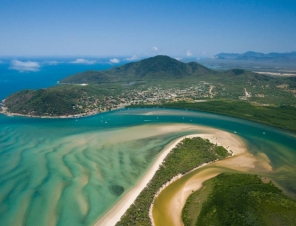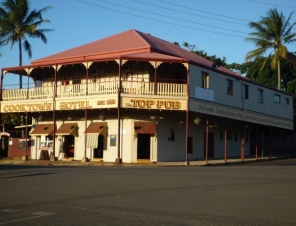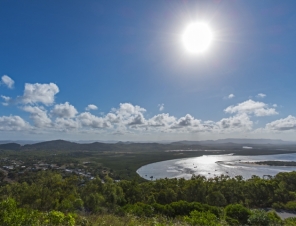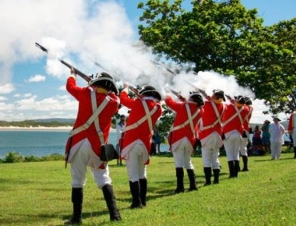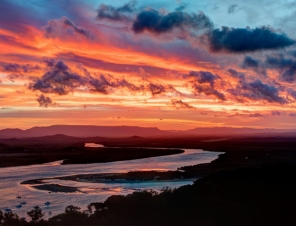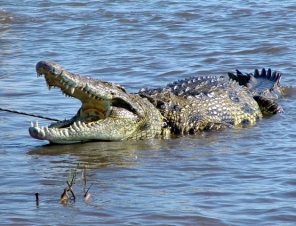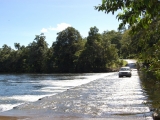Cooktown is located at the mouth of the Endeavour River, on Cape York Peninsula in Far North Queensland where James Cook beached his ship, the Endeavour, for repairs in 1770. With a population of 2,400, both the town and Mount Cook (431 metres or 1,415 feet) which rises up behind the town were named after James Cook.
Cooktown is the northernmost town on the east coast of Australia and was founded on 25 October 1873 as a supply port for the goldfields along the Palmer River. It was called 'Cook's Town' until 1 June 1874.
In the local aboriginal "Guugu Yimithirr" language the name for the region is, Gan.gaarr, which means "(Place of the) Rock Crystals". Quartz crystals were used in various Aboriginal ceremonies across the continent and are found in the vicinity; they were traded from the Cooktown region at least as far as Mossman, about 300 km south of Cooktown, and possibly much further.
The site of modern Cooktown was the meeting place of two vastly different cultures when, in June 1770, the local Aboriginal Guugu Yimithirr tribe cautiously watched the crippled sailing ship - His Majesty's Bark Endeavour - limp up the coast seeking a safe harbour after sustaining serious damage to its wooden hull on the Endeavour Reef, south of Cooktown. The Guugu Yimithirr people saw the Endeavour beach in the calm waters near the mouth of their river, which they called "Wahalumbaal".
The captain of the Endeavour, Lieutenant James Cook, wrote: "it was happy for us that a place of refuge was at hand; for we soon found that the ship would not work, and it is remarkable that in the whole course of our voyage we had seen no place that our present circumstances could have afforded us the same relief".
The British crew spent seven weeks on the site of present-day Cooktown, repairing their ship, replenishing food and water supplies, and caring for their sick. The extraordinary scientist, Joseph Banks, and Swedish naturalist Daniel Solander, who accompanied Cook on the expedition, collected, preserved and documented over 200 new species of plants. The young artist Sydney Parkinson illustrating the specimens and he was the first British artist to portray Aboriginal people from direct observation.
After some weeks, Joseph Banks met and spoke with the local people, recording about 50 Guugu Yimithirr words, including the name of the intriguing animal the natives called gangurru (which he transcribed as "Kangaru"). Cook recorded the local name as "Kangooroo, or Kanguru". The first recorded sighting of kangaroos by Europeans was on Grassy Hill, which rises above the place where the ship was beached. Cook climbed this hill to work out a safe passage for the Endeavour to sail through the surrounding reefs, after it was repaired.
Cook named the river the "Endeavour" after his ship, and, as they sailed north, he hoisted the flag known as the "Queen Anne Jack" and claimed possession of the whole eastern coast of Australia for Britain. He named Cape York Peninsula after the then Duke of York ("The Grand Old Duke of York").
By 1940, little evidence of Cooktown or Maytown's interesting past remained and during the Second World War, Cooktown became an important base for the war effort. The civilian population of Cooktown was encouraged to evacuate in face of the Japanese advances and by 1942 the vast majority had left.
Some 20,000 Australian and American troops were stationed in and around the town. The busy airfield played a key role in the crucial Battle of the Coral Sea when Japanese expansion towards the Australian mainland was finally halted. The last military unit, the 27th Operational Base Squadron of the RAAF, ceased operations in Cooktown in April 1946.
Cooktown has a tropical savanna climate with the wet season from December to April, is typically hot and humid but sea breezes and rainfall keep temperatures at bay. The dry season from May to November is less hot and humid, though unlike most of tropical Australia onshore winds still produce some light showers. The highest daily rainfall in Cooktown has been 405.4 millimetres on the 22nd January 1914.
Is the stop in Cooktown a tendering port?
Yes, there is no port suitable for the cruise ships so they moor off shore and you are taken ashore by the ships tenders.

 |
|





